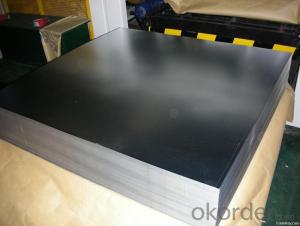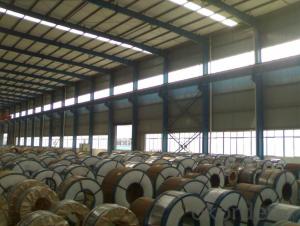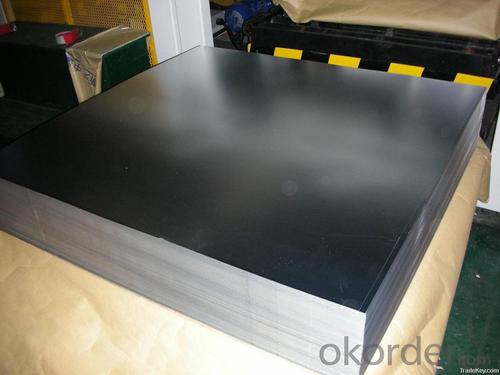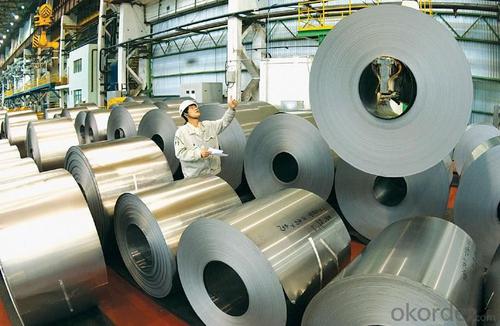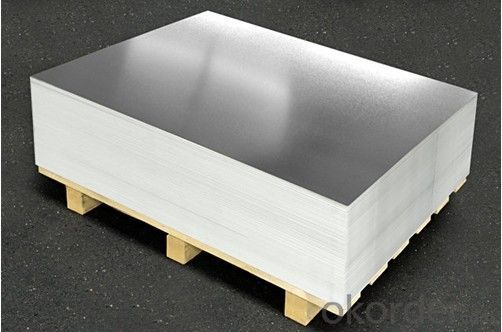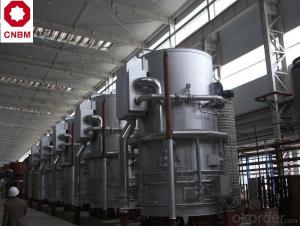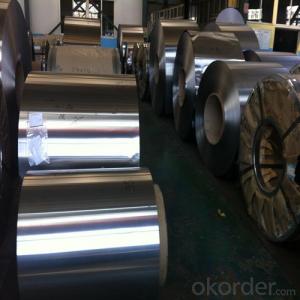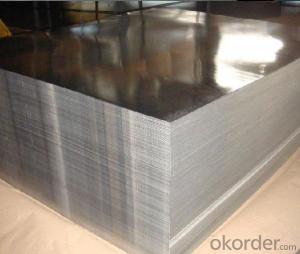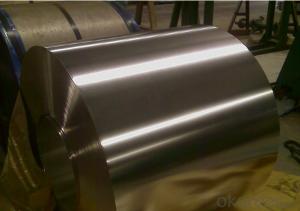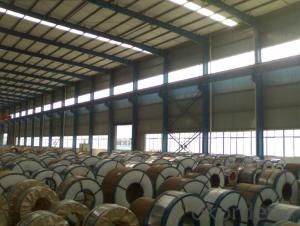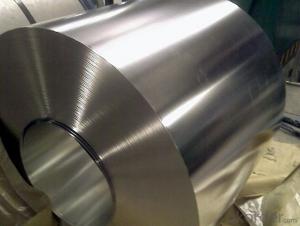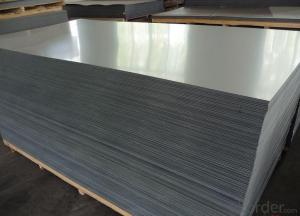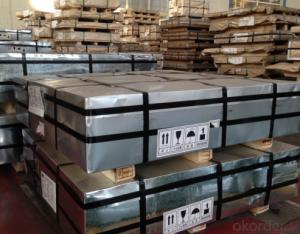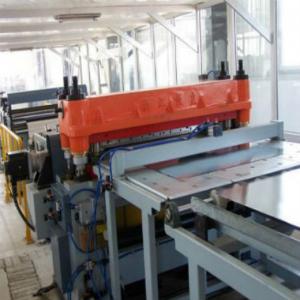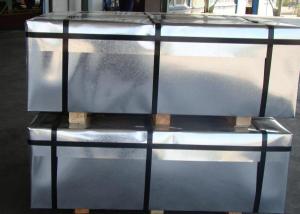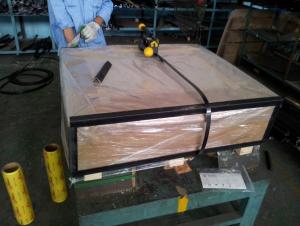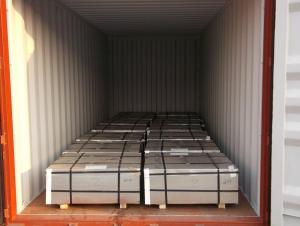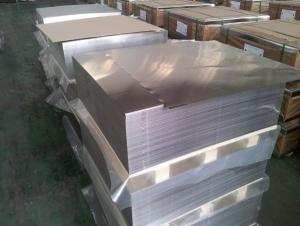Electrolytic Tinplate Coil and Sheets for Food Cans Packing
- Loading Port:
- Tianjin
- Payment Terms:
- TT OR LC
- Min Order Qty:
- 25 m.t
- Supply Capability:
- 7000 m.t/month
OKorder Service Pledge
OKorder Financial Service
You Might Also Like
1.Structure of Electrolytic Tinplate Coil and Sheets for Food Cans Packing Description
Electrolytic Tin Plate Coils and Sheets for Foods Metal Packaging, is one thin steel sheet with a coating of tin applied by electrolytic deposition. Tinplate made by this process is essentially a sandwich in which the central core is strip steel. This core is cleaned in a pickling solution and then fed through tanks containing electrolyte, where tin is deposited on both sides. As the strip passes between high-frequency electric induction coils, it is heated so that the tin coating melts and flows to form a lustrous coat.
2.Main Features of the Electrolytic Tin Plate Coils and Sheets for Foods Metal Packaging
Appearance – Electrolytic Tin Plate is characterized by its beautiful metallic luster. Products with various kinds of surface roughness are produced by selecting the surface finish of the substrate steel sheet.
Paintability and printability – Electrolytic Tin Plates have excellent paintability and printability. Printing is beautifully finished using various lacquers and inks.
Formability and strength – Electrolytic Tin Plates have got very good formability and strength. By selecting a proper temper grade, appropriate formability is obtained for different applications as well as the required strength after forming.
Corrosion resistance – Tinplate has got good corrosion resistance. By selecting a proper coating weight, appropriate corrosion resistance is obtained against container contents. Coated items should meet 24 hour 5 % salt spray requirement.
Solderability and weldability – Electrolytic Tin Plates can be joined both by soldering or welding. These properties of tinplate are used for making various types of cans.
Hygienic – Tin coating provides good and non toxic barrier properties to protect food products from impurities, bacteria, moisture, light and odours.
Safe – Tinplate being low weight and high strength makes food cans easy to ship and transport.
Eco friendly – Tinplate offers 100 % recyclability.
Tin is not good for low temperature applications since it changes structure and loses adhesion when exposed to temperatures below – 40 deg C.
3.Electrolytic Tin Plate Coils and Sheets for Foods Metal Packaging Images
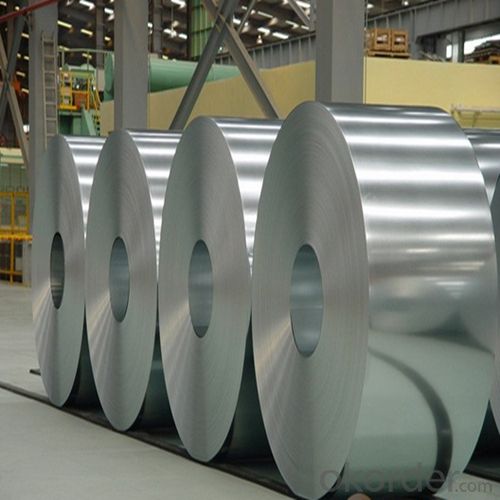
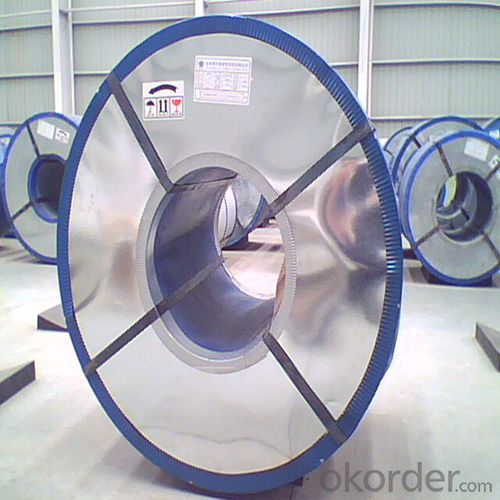
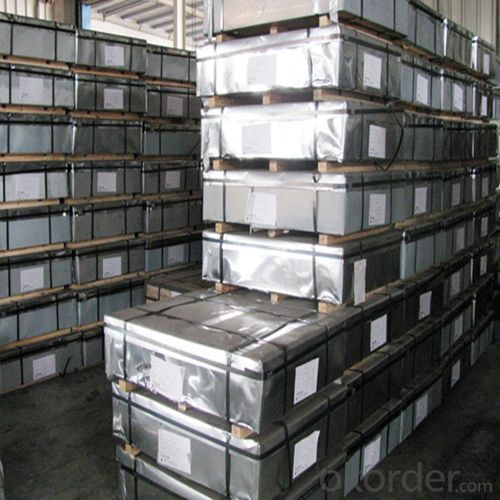
4.Electrolytic Tin Plate Coils and Sheets for Foods Metal Packaging Specification
Standard | ISO 11949 -1995, GB/T2520-2000,JIS G3303,ASTM A623, BS EN 10202
|
Material | MR,SPCC |
Thickness | 0.15mm - 0.50mm |
Width | 600mm -1150mm |
Temper | T1-T5 |
Annealing | BA & CA |
Coil Inner Diameter | 508mm |
Weight | 6-10 tons/coil 1~1.7 tons/sheets bundle |
Passivation | 311 |
Oil | DOS |
Surface | Finish,bright,stone,matte,silver |
5.FAQ of Electrolytic Tin Plate Coils and Sheets for Foods Metal Packaging
- How are the Electrolytic Tin Plates specified?
The Electrolytic Tin Plates are specified as per the steel base, extent of tempering, the coating weight, annealing method and the surface finish.
- How many types there are for base steels?
The base steels are of three types: Type MR, L, D
-What your tinplate material is used for ?
Tinplate is widely used for the packaging of products. Such as food cans,
beverage cans, pet cans, closures, general line cans and so on.
Printed Tinplate is offered!!
-How to place .an order or contact you ?
Please send us Email. we will give you a quick response in seconds .
- How is your quality ?
All our quality is prime even the secondary quality . We have many years experience
In this field with serious quality control standard . Advanced equipment, We welcome your visit to our factory .
- Q: How is tinplate coated for paint cans?
- Tinplate is coated for paint cans using a process called electrolytic tin coating. This involves immersing the tinplate in an electrolyte solution and passing an electric current through it. The current causes tin ions to be deposited onto the surface of the tinplate, creating a thin layer of tin coating. This tin coating provides the necessary corrosion resistance and ensures the paint cans remain durable and long-lasting.
- Q: How is tinplate coated for promotional items?
- Tinplate is typically coated for promotional items using a process called electrolytic tin plating. This involves immersing the tinplate into an electrolyte solution and passing an electric current through it, causing tin ions to be deposited onto the surface of the metal. This coating provides a protective barrier against corrosion and enhances the appearance of the tinplate, making it suitable for various promotional items.
- Q: What are the different printing techniques used on tinplate?
- There are several different printing techniques used on tinplate, including lithography, offset printing, screen printing, and digital printing. These methods allow for high-quality and vibrant designs to be applied to tinplate surfaces, making them suitable for various packaging and promotional materials.
- Q: Can tinplate be used for promotional and gift items?
- Yes, tinplate can be used for promotional and gift items. Tinplate is a versatile material that can be easily decorated and customized, making it an ideal choice for creating unique and eye-catching promotional and gift items. Its durability and ability to retain its shape and design over time also make it a popular option for such purposes.
- Q: How is tin coating applied to the steel substrate?
- Tin coating is typically applied to the steel substrate through a process called electroplating. In this method, the steel substrate is first cleaned and prepared to ensure proper adhesion of the tin coating. It is then immersed in an electrolyte bath containing tin salts, and an electrical current is applied. The current causes the tin ions to be reduced and deposited onto the steel surface, forming a thin layer of tin coating. This electroplating process helps to improve the corrosion resistance and appearance of the steel substrate.
- Q: How is tinplate used in the automotive industry?
- Tinplate is commonly used in the automotive industry for manufacturing various components such as fuel tanks, exhaust systems, and body panels. It provides excellent corrosion resistance, making it suitable for protecting these parts from rust and other environmental damage. Additionally, tinplate is lightweight yet strong, contributing to fuel efficiency and overall vehicle performance.
- Q: What are the recommended soldering techniques for tinplate?
- The recommended soldering techniques for tinplate include pre-tinning the surfaces to be soldered, using a low-temperature soldering iron, ensuring proper ventilation, and using flux to promote good solder flow. It is also important to avoid excessive heat, as tinplate can be easily damaged.
- Q: What are the transportation considerations for tinplate?
- The transportation considerations for tinplate typically revolve around its weight, fragility, and potential for damage. Tinplate is quite heavy, so proper handling and lifting equipment are necessary to ensure safe transportation. Its fragile nature means that it should be protected from impacts and vibrations during transit to prevent dents, scratches, or other damage. Additionally, as tinplate is susceptible to corrosion, it is important to protect it from moisture and humidity during transportation, such as by using proper packaging and ensuring a dry environment.
- Q: What are the main factors influencing the growth of the tinplate industry?
- The main factors influencing the growth of the tinplate industry include increasing demand for packaged food and beverages, expanding urbanization and industrialization, advancements in technology leading to improved production processes, and the growing awareness about the benefits of metal packaging such as durability, recyclability, and food safety. Additionally, economic growth in emerging markets and the rising disposable income of consumers are also driving the growth of the tinplate industry.
- Q: What are the disadvantages of using tinplate in packaging?
- One of the disadvantages of using tinplate in packaging is its susceptibility to corrosion. Tinplate can rust when exposed to moisture and other corrosive elements, which can compromise the integrity of the packaging and potentially contaminate the product. Additionally, tinplate is relatively heavy compared to other packaging materials, which can increase transportation costs and carbon footprint. Lastly, tinplate is not as malleable as other materials, limiting its versatility in certain packaging designs.
Send your message to us
Electrolytic Tinplate Coil and Sheets for Food Cans Packing
- Loading Port:
- Tianjin
- Payment Terms:
- TT OR LC
- Min Order Qty:
- 25 m.t
- Supply Capability:
- 7000 m.t/month
OKorder Service Pledge
OKorder Financial Service
Similar products
Hot products
Hot Searches
Related keywords
